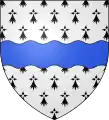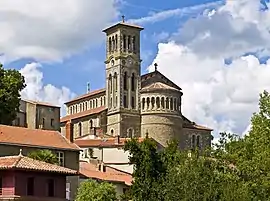Loire-Atlantique
| |
|---|---|
_-_Nantes.jpg.webp) Prefecture building in Nantes | |
 Flag  Coat of arms | |
 Location of Loire-Atlantique in France | |
| Coordinates: 47°20′N 1°40′W / 47.333°N 1.667°W | |
| Country | France |
| Region | Pays de la Loire |
| Prefecture | Nantes |
| Subprefectures | Châteaubriant Saint-Nazaire |
| Government | |
| • President of the Departmental Council | Michel Menard[1] (PS) |
| Area | |
| • Total | 6,881 km2 (2,657 sq mi) |
| Population | |
| • Total | 1,457,806 |
| • Rank | 9th |
| • Density | 210/km2 (550/sq mi) |
| Time zone | UTC+1 (CET) |
| • Summer (DST) | UTC+2 (CEST) |
| Department number | 44 |
| Arrondissements | 3 |
| Cantons | 31 |
| Communes | 207 |
| ^1 French Land Register data, which exclude estuaries, and lakes, ponds, and glaciers larger than 1 km2 | |
Loire-Atlantique (French pronunciation: [lwaʁ atlɑ̃tik]; Gallo: Louére-Atantique; Breton: Liger-Atlantel; before 1957: Loire-Inférieure,[3] Breton: Liger-Izelañ) is a department in Pays de la Loire on the west coast of France, named after the river Loire and the Atlantic Ocean. It had a population of 1,429,272 in 2019.[4]
History

Loire-Atlantique is one of the original 83 departments created during the French Revolution on March 4, 1790. Originally, it was named Loire-Inférieure, but its name was changed in March 9, 1957 to Loire-Atlantique.[3]
The area is part of the historical Duchy of Brittany, and contains what many people still consider to be Brittany's capital, Nantes. However, during World War II, the Vichy Government set up a system of regional prefectures whereby on 19 April 1941 Loire-Atlantique was excluded from the Region of Brittany and united with neighbouring French departments, under the lead of Angers.
After the war these administrative changes were reimplemented in the 1955 boundary changes intended to optimise the management of the regions. There has since been a series of campaigns reflecting a strong local mood to have the department reintegrated with Brittany.
Geography
Loire-Atlantique is part of the current region of Pays de la Loire and is surrounded by the department of Morbihan, Ille-et-Vilaine, Maine-et-Loire, and Vendée, with the Atlantic on the west.
Principal towns
The most populous commune is Nantes, the prefecture. As of 2019, there are 9 communes with more than 20,000 inhabitants:[4]
| Commune | Population (2019) |
|---|---|
| Nantes | 318,808 |
| Saint-Nazaire | 71,394 |
| Saint-Herblain | 47,415 |
| Rezé | 42,919 |
| Saint-Sébastien-sur-Loire | 27,493 |
| Orvault | 27,209 |
| Vertou | 25,541 |
| Couëron | 22,309 |
| Carquefou | 20,365 |
Demographics
Population development since 1801:
|
| ||||||||||||||||||||||||||||||||||||||||||||||||||||||||||||||||||||||||||||||||||||
| Sources:[3][5] | |||||||||||||||||||||||||||||||||||||||||||||||||||||||||||||||||||||||||||||||||||||
Culture
Upper Brittany's indigenous language is Gallo, a romance language related to French. The number of Gallo language speakers has been in steady decline since the early 20th century. The language is neither official nor taught in primary or secondary education. In the south of the département (Pays de Retz), the local language was Poitevin dialect.
The Breton language, a Celtic language, native to Lower Brittany, was historically spoken in the western area of Loire-Atlantique, and up to 1920 in Batz-sur-Mer. This area (Guérande, Le Croisic, and La Baule) has a rather Breton toponymy: for instance, Guérande originates from the Breton Gwenn Rann (white or pure place).
The folklore and musical traditions of eastern or Upper Brittany are generally similar to those of western or Lower Brittany.
Politics
The president of the Departmental Council is Michel Menard, elected in July 2021.
Current Deputies of the National Assembly
Current Senators
| Senator | Party | |
|---|---|---|
| Ronan Dantec (fr) | DVG | |
| Joël Guerriau (fr) | UDI | |
| Michelle Meunier (fr) | SOC | |
| Christophe Priou | UMP | |
| Yannick Vaugrenard | SOC | |
Political movements
The capital of the administrative region is Rennes, although Nantes is considered the capital of historic Brittany and is located in Loire-Atlantique. The reunification of historic Brittany is supported by a majority of Loire-Atlantique and is considered a prerequisite to further autonomy of Brittany as a whole.[7][8]
Transport

The département operates the Lila network (fr) of interurban buses, which link its villages, towns and cities. The urban areas of Nantes and Saint-Nazaire operate their own urban transport networks, known as TAN and STRAN (fr) respectively.
By rail, the regional trains and buses of the TER Pays de la Loire link major towns and cities of the Pays de la Loire and adjoining regions, including those of the département. Nantes is on the TGV network, with high speed trains running to Paris by the LGV Atlantique in just over 2 hours.
Nantes Atlantique Airport, located 8 km to the southwest of the city of Nantes, serves the département and surrounding areas. It is the biggest airport in northwestern France, linking with several French, North African and European cities, as well as Montreal in Canada.
Tourism

 Stained glass-window of the church of Batz-sur-Mer
Stained glass-window of the church of Batz-sur-Mer

 Coast near Le Pouliguen
Coast near Le Pouliguen
See also
References
- ↑ "Répertoire national des élus: les conseillers départementaux". data.gouv.fr, Plateforme ouverte des données publiques françaises (in French). 4 May 2022.
- ↑ "Téléchargement du fichier d'ensemble des populations légales en 2021". The National Institute of Statistics and Economic Studies. 28 December 2023.
- 1 2 3 "Historique de la Loire-Atlantique". Le SPLAF.
- 1 2 Populations légales 2019: 44 Loire-Atlantique, INSEE
- ↑ "Évolution et structure de la population en 2016". INSEE.
- ↑ Nationale, Assemblée. "Assemblée nationale ~ Les députés, le vote de la loi, le Parlement français". Assemblée nationale (in French). Retrieved 2021-03-26.
- ↑ "La moitié des habitants de la Bretagne à 5 favorables à un rattachement de la Loire-Atlantique". archive.wikiwix.com. Retrieved 2023-10-18.
- ↑ "Brittany lays claim to autonomy, in Corsica's footsteps". Le Monde.fr. 2022-04-09. Retrieved 2023-10-18.
External links
- (in French) Prefecture
- (in French) Departmental Council
- (in English) Loire-Atlantique Tourism